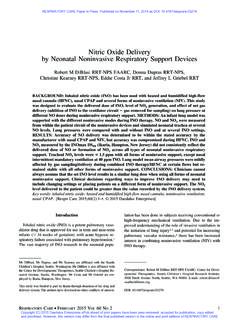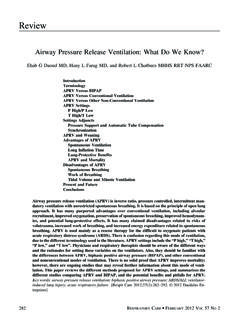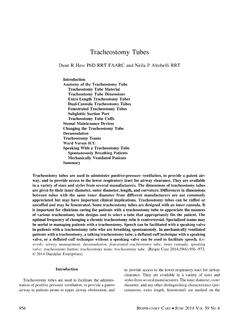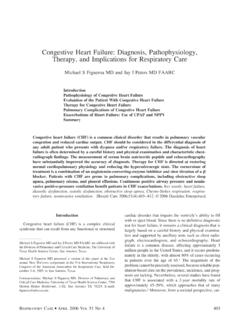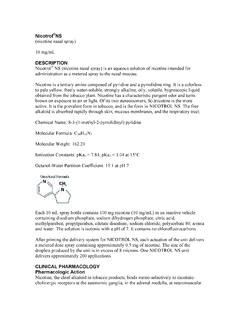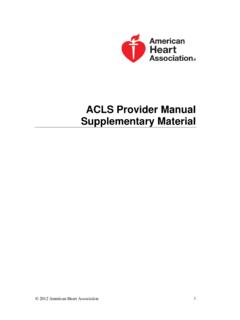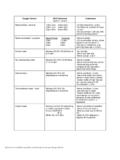Transcription of High-Flow Nasal Cannula Oxygen Therapy in Adults ...
1 High-Flow Nasal Cannula Oxygen Therapy in Adults : PhysiologicalBenefits, Indication, clinical benefits , and Adverse EffectsMasaji Nishimura MD PhDIntroductionAdverse Effects of Lack of HumidificationHumidification Performance of High-Flow Nasal Cannula DevicesInterfacePhysiological EffectFraction of Inspired OxygenPEEP EffectClinical TrialsHypercapnic Respiratory FailureHypoxemic Respiratory FailurePostextubationPreintubation OxygenationAcute Heart FailureSleep ApneaOther ConditionsAdverse EffectsContraindicationConclusionsHigh-f low Nasal Cannula (HFNC) Oxygen Therapy is carried out using an air/ Oxygen blender, activehumidifier, single heated tube, and Nasal Cannula . Able to deliver adequately heated and humidifiedmedical gas at flows up to 60 L/min, it is considered to have a number of physiological advantagescompared with other standard Oxygen therapies, including reduced anatomical dead space, PEEP,constant FIO2, and good humidification.
2 Although few large randomized clinical trials have beenperformed, HFNC has been gaining attention as an alternative respiratory support for critically illpatients. Published data are mostly available for neonates. For critically ill Adults , however, evi-dence is uneven because the reports cover various subjects with diverse underlying conditions, suchas hypoxemic respiratory failure, exacerbation of COPD, postextubation, preintubation Oxygen -ation, sleep apnea, acute heart failure, and conditions entailing do-not-intubate orders. Even so,across the diversity, many published reports suggest that HFNC decreases breathing frequency andwork of breathing and reduces the need for respiratory support escalation. Some important issuesremain to be resolved, such as definitive indications for HFNC and criteria for timing the startingand stopping of HFNC and for escalating treatment.
3 Despite these issues, HFNC has emerged as aninnovative and effective modality for early treatment of Adults with respiratory failure with diverseunderlying words: noninvasive ventilation; High-Flow Oxygen Therapy ; escalation; ran-domized; controlled trials; humidification.[Respir Care 2016;61(4):529 541. 2016 DaedalusEnterprises]RESPIRATORYCARE APRIL2016 VOL61 NO4529 IntroductionRespiratory support is applied to maintain adequate ox-ygenation and alveolar ventilation, and the first-line treat-ment for hypoxemic respiratory failure is supplementaloxygen. During spontaneous breathing, inspired air passesthrough the nose, pharynx, larynx, and trachea. Due to thegreat ability of the human nose and upper airway to warmand humidify inspired gas, on the way down to the alveoli,inspired air is warmed up to body temperature and fullysaturated with water vapor.
4 The nose and upper airway arealso excellent radiators: During natural breathing, evenwhen the ambient air is cold and dry, they are capable ofmaintaining temperature in the oropharyngeal Oxygen , however, is not usually humidified whenadministered at low flow. Bubble humidifiers are some-times used for humidifying medical gas delivered to spon-taneously breathing patients, but the absolute humidity ofthe emergent gas remains or poorly humidifiedmedical gas may elicit patient complaints, such as drynose, dry throat, and Nasal pain, and consequent poor tol-erance of Oxygen Therapy . Unconditioned gas increasesairway resistance to protect the lungs from dry or coldinspired air by reducing the air flow in the upper airwaysand ,4 Breathing dry air is known to reduce nasalmucoclliary conventional devices, oxy-gen flow is limited to no more than 15 L/min.
5 Meanwhile,the required inspiratory flow for patients with respiratoryfailure varies widely in a range from 30 to 120 difference between patient inspiratory flow and de-livered flow is large with conventional Oxygen devices,and FIO2is inconstant and generally lower than ,8 Administered via an air/ Oxygen blender, active heatedhumidifier, single heated circuit, and Nasal Cannula , High-Flow Nasal Cannula (HFNC) Oxygen Therapy has been gain-ing attention as an alternative means of respiratory supportfor critically ill patients. The air/ Oxygen blender is set forFIO2between and at up to 60 L/min flow (Fig. 1).9 Heated and humidified by the active humidifier, the gas isdelivered through the heated circuit. Warm and adequatelyhumidified gas delivered at high flow has apparent bene-ficial physiological effects. Although recently, results oflarge randomized clinical trials have been reported,10,11even before those trials, HFNC was widely applied tocritically ill patients with diverse underlying provides medical gases at higher flow and withmore predictable FIO2than with other devices.
6 Throughsuch an open circuit, we cannot expect high end-expiratorypressure, but it reportedly creates PEEP and may increaseend-expiratory lung volume (EELV).12 Currently, to ensure adequate alveolar ventilation, min-ute ventilation is manipulated during invasive or noninva-sive ventilatory support. For patients with COPD exacer-bation, noninvasive ventilation (NIV) has become thepreferred primary modality for respiratory support becauseit boosts inspiratory tidal volume (VT) and maintains ad-equate alveolar to poor mask tolerance,however, NIV is inapplicable to some ma-jor difference between NIV and HFNC is the NIV interfaces increase anatomical dead space,HFNC actually decreases dead space. When the circuit isso open, however, without effective inspiratory push orexpiratory pull, HFNC cannot actively enhance VT.
7 Be-sides decreasing anatomical dead space, HFNC also im-proves alveolar ventilation. In view of these advantagesthat cover some of the inadequacies of conventional oxy-gen delivery systems and apparent beneficial physiologi-cal effects, the use of HFNC for critically ill Adults hasbeen dramatically increasing. The simplicity and excellenttolerance of the system is especially attractive. HFNC issimple and easy, it makes the start of respiratory supportThe author is affiliated with the Department of Emergency and CriticalCare Medicine, Tokushima University Graduate School, Kuramoto,Tokushima, Nishimura has disclosed no conflicts of : Masaji Nishimura MD PhD, Emergency and Critical CareMedicine, Tokushima University Graduate School, 3-18-15 Kuramoto,Tokushima 770-8503, Japan. E-mail: 1. Basic setup for High-Flow Nasal Cannula Oxygen delivery.
8 Anair- Oxygen blender, allowing from to FIO2, generates up to60 L/min flow. The gas is heated and humidified through an activeheated humidifier and delivered via a single-limb heated inspira-tory circuit. The patient breathes adequately heated and humidi-fied medical gas through large-diameter Nasal cannulas. (Modifiedfrom Reference 9.)HFNCINADULTS530 RESPIRATORYCARE APRIL2016 VOL61 NO4earlier, and it has a possibility of decreasing the use ofmechanical Effects of Lack of HumidificationDry gas may have diverse adverse effects on the respi-ratory system. In dogs, breathing dry air causes completecessation of the flow of tracheal mucus16and, in culturedhuman epithelial cells, it causes acute damage and guinea pigs, it induces widespread loss of thecilia, associated with detachment or sloughing of the epi-thelium, subepithelial vascular congestion, edema, and cel-lular is also well-known that cold air in-duces bronchoconstriction in patients with resistance increases to protect the lungs from thechallenge of dry and cold gas by reducing the air flow inthe upper airways and ,4 Breathing dry air causesexcessive water loss by the Nasal mucosa.
9 20which may inturn reduce the Nasal mucoclliary clearance rate via changesin the rheological properties or adhesiveness of Nasal mu-cus and/or slowing of ciliary and dry gas may have adverse effects onpatients with respiratory failure. Conventional Oxygen de-vices are associated with mask discomfort, Nasal dryness,oral dryness, eye irritation, Nasal and eye trauma, and gas-tric ,21 Nasal obstruction of patients with ob-structive sleep apnea22receiving CPAP is inflammatory inorigin, and the addition of heated humidification decreasesnasal resistance and mucosal NIVdelivers medical gas at high flow, oral dryness and patientdiscomfort are likely with poorly conditioned humidity of gas delivered through oronasal masksduring NIV, which is affected by humidifier settings andamount of leakage, varies among patients at equivalenthumidifier settings.
10 Occasionally, High-Flow dry gas re-sults in inspissated secretions that cause life-threateningairway mechanically ventilated patients,when an endotracheal or tracheostomy tube bypasses theupper airway, where most humidification would naturallyoccur, poor humidification increases in the incidence ofendotracheal tube little as 5 min of deliv-ery of ambient gas directly at the trachea can cause asignificant decrease in pulmonary compliance and conduc-tance in contrast, conditioning of the gas minimizes airwayconstriction, reduces the work of breathing (WOB), im-proves mucociliary function,5facilitates clearance of se-cretions, and is associated with less atelectasis, resulting ina good ventilation/perfusion ratio and better humidification Therapy statistically significantlyreduces days of exacerbation, increases time to first exac-erbation, and generally improves lung function and qualityof life in subjects with COPD and Performance of HFNC DevicesBecause HFNC delivers medical gas at up to 60 L/minflow, it has the potential to cause the same adverse effectsof inadequate humidification as NIV.
